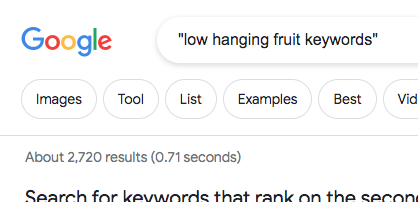Low hanging fruit keywords are the keywords with much less competition than the rest. For new blogs especially, Google won’t give you much authority until you’ve proved yourself. When you have a bunch of content on your site, they might start to approve your blog. But if your blog posts have highly competitive keywords in their titles, Google won’t rank them on the SERPS – Search Engine Results Pages. This can make it really difficult to get traffic to a blog for free.
So, instead of writing content using high competition keywords in your blog titles, use low hanging fruit keywords instead. Those keywords tend to have much less monthly searches. So you won’t get heaps of traffic even if you rank highly for them. But with many pieces of content, you’ll start to attract trickles of traffic from the SERPS. Plus, you’ll gain a growing authority from Google as you start to increase the volume of content on your site.
Low hanging fruit keywords are key to building content and authority and getting free traffic to your website/blog. As time goes on, your authority increases and you can rank for more competitive keywords too.
Low Hanging Fruit Keywords – Finding Them
To find low hanging fruit keywords you can use Google’s free keyword planner. Type in your main “seed” keyword and you should see a bunch of related terms which have been searched for on Google’s search engine. Here’s the search I did when I came upon this article title:

As you can see, the search tool throws up a bunch of related terms. Sift through these terms and look for the longer tail keywords. These tend to have fewer searches. Short tail keywords (of two to three terms) tend to have a larger search volume but they’re usually more competitive too. So ranking your content for them is much more difficult.
To help determine a keyword terms difficulty, head over to Google and type in your chosen keyword. For me, this was “Low hanging fruit keywords”. Here’s what came up with a normal and a phrase match Google search:


Look at the numbers which appear under the search bar. These numbers indicate the number of websites/pages which compete for these particular terms. So a high number would indicate a large volume of competition and a low number would indicate less competition.
These numbers indicated that I had a chance of ranking for this term, so hence I’m writing this article! These numbers will only appear on a laptop/desktop computer and they don’t appear on a mobile.
Finding The Lowest Hanging Fruit
The lowest “hanging fruit” when it comes to keywords are those with zero monthly searches. These terms don’t even appear on the search tool because there’s not enough data on them.
But this doesn’t necessarily mean those terms are never used, just that the tool doesn’t pick up that information because the numbers are so low. Plus, some searches will not have been done yet, even though they will appear in the future. So getting content out there for these search terms can work wonders if there’s hardly any competition.

Since these terms can be hard to find, look instead for those with the smallest monthly search volume. To do this, type in your seed keyword and click on the Avg. monthly search volume tab above the column of results until you see the longer term keywords with the lowest search volumes. Usually this is from zero to 10 monthly searches.
Now you can take the search terms you want to use and type them into Google to compare the relative competitiveness of them.
Creating Content
Once you find a good long tail keyword with low SEO difficulty it’s time to write some content for it. Use an SEO tool to help you write Search Engine Optimised content for it. I use Yoast SEO. This tool will help you get your keywords in your titles, descriptions and other relevant fields. It will also help you get the balance right as to how much to use your term within any given piece of content.
Ideally write a high quality article which will stand the test of time. It can also be useful to look at the current top result on Google. This can give you an idea about how many words and what standard Google already ranks highly. Then set about out-doing this content with your own.
With high quality content, your visitors should get some value from your writing. In this case, they are more likely to link to it or share it on social media. With a bad piece of content this is unlikely to happen at all. Over time, more backlinks and social media shares will affect your authority with Google and how your website is perceived. So write high quality content if you want your articles to rank.

Some of your content simply won’t rank, and you’re never guaranteed a ranking. But keep creating content and build up the volume of posts on your blog. Over time, your Google authority should improve and this means you can write for more competitive keyword terms and be in with a chance of ranking for them later.
With a new blog, it is very unlikely that Google will rank your content for a competitive term; even if your content is better than whatever else is out there!
Low Hanging Fruit Keywords – Ranking On Page 1-2 Of Google Already
“Low hanging fruit” keywords can also refer to those keywords which you already have on your website, but for which you aren’t currently ranking highly. So if your content ranks on the bottom of page 1 of Google, for example, or at the top of page 2, you might be able to affect change quite easily, (hence low hanging fruit).
To find these terms you can use software such as Google search console or SEM Rush. They can show you the content on your website which could rank near the top of page one, with only a little work.
Once you have identified a piece of your content which could easily move up the rankings to near the top of page one, you can go to work on that content and improve it. Build more backlinks and add to your content. Go over it and look for ways to improve it and correct any errors.
As you improve your page score, you should see it move up the placings listing.
The best way to work on increasing your traffic can be to identify your website’s pages which rank on page one or two (near the top) and which have a good search volume for that particular keyword. Then a little work can go a long way!



